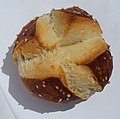Lye roll
Pretzels (in Switzerland silserli or Silserbrot in Austria also Laugenweckerl ) is a small pastries , in which the dough pieces mostly from a the white bread corresponding wheat dough (there are such. As well as lye croissants from puff pastry ) prepares and before baking in Caustic soda ( food additive E 524 ). In commercial production, this is limited to a maximum of 4% concentration of the lye. The lye reacts with the gluten in the dough and releases amino acids . The amino acids enter into a Maillard reaction with the sugars . This creates the typical shimmering brown surface during baking, and the pastry gets its special, strong taste. The lye only remains on the surface of the dough and does not penetrate the dough.
Incompatibility with aluminum sheets
The sodium hydroxide solution and immersed in liquor dough pieces may not directly participate in the production of aluminum sheets come into contact, because the sodium hydroxide solution, the protective oxide layer destroyed the aluminum sheet, placing them in sodium aluminate are reacted. The exposed elemental aluminum reacts with the release of hydrogen to form aluminum hydroxide , which in turn is converted to sodium aluminate with the remaining sodium hydroxide solution. For this reason, pretzels should not be baked on aluminum sheet or foil, as this can cause aluminum contamination of the baked goods.
History of origin
There are various legends and explanations about the origins of pretzels and pretzels. According to a "Swabian legend", which supposedly goes back to 1477, the Urach master baker Frieder not only invented the pretzel out of necessity , but also a cat jumped on the baking sheet, so that all the dough pieces fell into a bucket of hot lye. The “Bavarian version” of the story of its origins, however, tells of the baker Anton Nepomuk Pfannenbrenner, who worked in the royal coffee house of the purveyor Johann Eilles in Munich in the 19th century. There he made a fatal mistake in the bakery on February 11, 1839: he usually glazed the pretzels with sugar water, but on that day he accidentally reached for the caustic soda that was actually provided to clean the trays. His superiors were enthusiastic about the result, so that on the same day they gave the Royal Württemberg ambassador Wilhelm Eugen von Ursingen a pretzel to taste.
species
Typical Lye Bakery are small pastries like the lye pretzel , the pretzel rolls (also Laugenweckle , pretzel roll , Silserbrötli ), the pretzel stick and the so-called lye confectionery - chocolates large pretzel pieces with various sprinkled ingredients (poppy, sesame, etc.) and the Silserkranz in German-speaking Switzerland. Pretzel bagels and lozenges are also being produced more and more frequently and are often offered for sale topped with various ingredients. In addition there is the pretzel croissant , in Switzerland: Silsergipfeli . Pretzels are traditionally made with lard. Today, however, many bakers use vegetable fats.
The thin pretzel sticks, on the other hand, are permanent pastries and belong to the fine baked goods .
The main distribution area of the pretzel biscuits is southern Germany (Baden-Württemberg and Bavaria), Austria and German-speaking Switzerland , but it can now also be found under different names far beyond Germany .
Silserbrot
The German- Swiss names Silserli , Silserbrot , Silserbretzel are possibly derived from “Salse”, the caustic soda in which the baked goods are dipped (Latin sal = salt). An alternative explanation leads them back to the name of the Engadin town of Sils ; The dialect expert Markus Gasser thinks this is wrong. In French-speaking and Italian-speaking Switzerland, reference is also presumably made to Sils in the Engadin: “pain de Sils” or “pane di Sils”.
Web links
Individual evidence
- ↑ Principles for bread and biscuits . (PDF) Federal Ministry of Food, Agriculture and Consumer Protection, February 25, 2012, p. 7
- ^ Josef Loderbauer: The baker's book in learning fields . Verlag Handwerk und Technik, Hamburg 2008, ISBN 978-3-582-40205-9 .
- ↑ 4.4.10 Reaction of aluminum with water and sodium hydroxide solution . Description of an experimental setup at the University of Siegen; Retrieved February 19, 2017
- ↑ Are pretzels contaminated with aluminum? , Associations for Independent Health Counseling eV, 2007, accessed on September 16, 2018
- ↑ Increased aluminum content in pretzels (PDF). Federal Institute for Risk Assessment , November 25, 2002, accessed on September 16, 2018
- ↑ Pretzels with increased aluminum content. In: Annual report of the food control in Baden-Württemberg for the year 2011 - general report. Ed .: Minister for Rural Areas and Consumer Protection Baden-Württemberg, p. 57, accessed on September 16, 2018
- ↑ a b The making of the pretzel pretzel. oktoberfestportal.de, accessed on August 30, 2015
- ↑ The pretzel owes its creation to an accident . In: Augsburger Allgemeine , December 5, 2014
- ↑ Guidelines for Fine Baked Goods (PDF) Federal Ministry of Food, Agriculture and Consumer Protection, February 25, 2012, page 9
- ↑ Markus Gasser: From “Silserli” to “Verhabni” . Schnabelweid mailbox, Swiss radio and television , November 1, 2012; see. for the alternative explanation Over 115 years of Hanselmann . History of the Hanselmann Bakery, St. Moritz, accessed on September 13, 2018.







